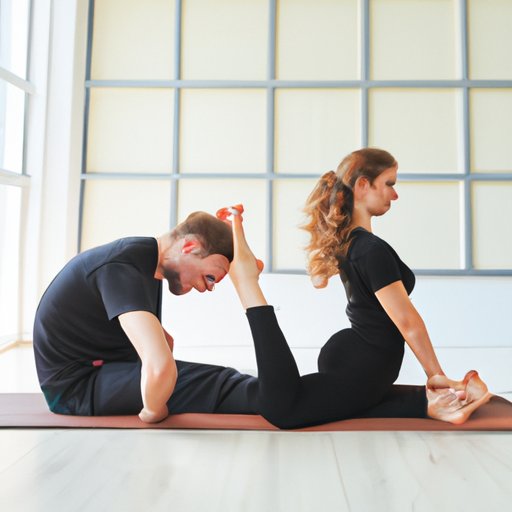Introduction
Being flexible is an important part of physical health and performance. Improved flexibility can help reduce the risk of injury, improve posture, increase range of motion, and enhance overall well-being. But how long does it take to become flexible? And what steps should you take to achieve your goals in a timely manner? In this article, we’ll explore the benefits of being flexible and provide a step-by-step guide to becoming flexible quickly.

Overview of the Benefits of Being Flexible
Flexibility describes the range of motion that a joint or muscle group can move through. Having good flexibility means having joints and muscles that can move and stretch without restriction, allowing for full range of motion. Good flexibility helps with everyday tasks such as reaching up to grab something from a shelf, bending down to tie your shoes, or even just turning your head to look behind you.
In addition to helping with everyday activities, increased flexibility can also benefit athletes and other physically active individuals. Studies have shown that increased flexibility can improve athletic performance, help prevent injuries, and reduce muscle soreness after exercise. Increased flexibility can also reduce stress levels, improve posture, and help improve balance and coordination.
Explaining the Time and Effort Involved in Getting Flexible
So how long does it take to become flexible? The answer to this question depends on several factors, including your current level of flexibility, the amount of time and effort you put into increasing your flexibility, and any underlying physical conditions you may have. Generally speaking, it can take anywhere from a few weeks to several months to become flexible, depending on your individual circumstances.
It’s important to note that becoming flexible takes more than just stretching. To become truly flexible, you will need to incorporate a variety of activities into your routine, such as proper warm-up and cool down routines, regular stretching and mobility exercises, and consistent strength training.

Tips for Increasing Flexibility in a Timely Manner
In order to increase your flexibility in a timely manner, it’s important to focus on the following areas:
Proper Warm-Up and Cool Down Routines
Before beginning any physical activity, it’s important to warm up your body properly. Warming up increases blood flow to the muscles and prepares them for activity. It also helps reduce the risk of injury. Effective warm-ups typically involve dynamic stretching, which involves moving through a full range of motion. After exercising, it’s also important to cool down. This helps reduce muscle soreness and stiffness, and helps restore your body to its pre-exercise state.
Regular Stretching and Mobility Exercises
Stretching and mobility exercises are key components of any flexibility program. Stretching helps to increase range of motion and improve flexibility, while mobility exercises help to improve joint stability and reduce the risk of injury. Regular stretching and mobility exercises should be done at least 2-3 times per week to see results.
Consistent Strength Training
Strength training is another important component of any flexibility program. Strength training helps build muscle strength and endurance, which can in turn help improve flexibility. Incorporating strength training into your routine can help you become more flexible faster.
A Step-by-Step Guide to Becoming Flexible Fast
If you’re looking to become flexible quickly, here is a step-by-step guide to help you get started:
Identifying Areas of Tightness
The first step in becoming flexible is to identify areas of tightness in your body. You can do this by performing simple tests such as reaching up to touch your toes or doing a side bend. Once you’ve identified areas of tightness, you can begin to target these areas with specific stretches and exercises.
Establishing a Flexibility Routine
Once you’ve identified areas of tightness, it’s important to establish a regular flexibility routine. This should include stretching, mobility exercises, and strength training. Aim to do these activities at least 2-3 times per week to see results.
Progressively Overloading Muscles
When trying to increase flexibility, it’s important to progressively overload the muscles. This means gradually increasing the intensity of your exercises over time. For example, if you’re doing a stretching routine, you could start with a basic stretch and then progress to a more advanced version as your flexibility improves.

What You Need to Know When Trying to Increase Flexibility
When trying to increase flexibility, there are a few things to keep in mind:
The Importance of Nutrition
Good nutrition is essential for increasing flexibility. Eating a balanced diet rich in protein, carbohydrates, healthy fats, fruits, and vegetables can help promote muscle growth and repair, which can in turn help improve flexibility. Additionally, staying hydrated is important for keeping muscles supple and reducing the risk of injury.
Understanding Your Body’s Limitations
It’s important to understand your body’s limitations when trying to become flexible. If you push yourself too hard, you may end up injuring yourself. Listen to your body and adjust your routine as necessary.
Adjusting Your Routine as Necessary
As you become more flexible, it’s important to adjust your routine accordingly. As your flexibility increases, you may need to add more challenging exercises or increase the intensity of your stretching routine. This will help ensure that you continue to make progress.
Strategies and Exercises for Improving Flexibility in a Short Period of Time
There are a few strategies and exercises you can use to help improve your flexibility in a short period of time. These include:
Dynamic Stretches
Dynamic stretching involves actively stretching your muscles by moving through a full range of motion. Examples of dynamic stretches include leg swings, arm circles, and walking lunges. Dynamic stretching is a great way to warm up before exercise and can help improve flexibility over time.
Foam Rolling
Foam rolling is a type of self-myofascial release that involves using a foam roller to apply pressure to tight muscles. Foam rolling can help reduce muscle tension, improve range of motion, and reduce the risk of injury. Foam rolling can be done before or after exercise and should be done at least once per week.
Static Stretching
Static stretching involves holding a stretch for an extended period of time. Static stretching is a great way to cool down after exercise and can help improve flexibility. Examples of static stretches include seated toe touches, standing quad stretches, and hip flexor stretches.
Conclusion
Becoming flexible takes time and effort, but the benefits are worth it. Improved flexibility can help reduce the risk of injury, improve posture, increase range of motion, and enhance overall well-being. By following the steps outlined in this article—including proper warm-up and cool down routines, regular stretching and mobility exercises, and consistent strength training—you can become more flexible in a short period of time.
(Note: Is this article not meeting your expectations? Do you have knowledge or insights to share? Unlock new opportunities and expand your reach by joining our authors team. Click Registration to join us and share your expertise with our readers.)
